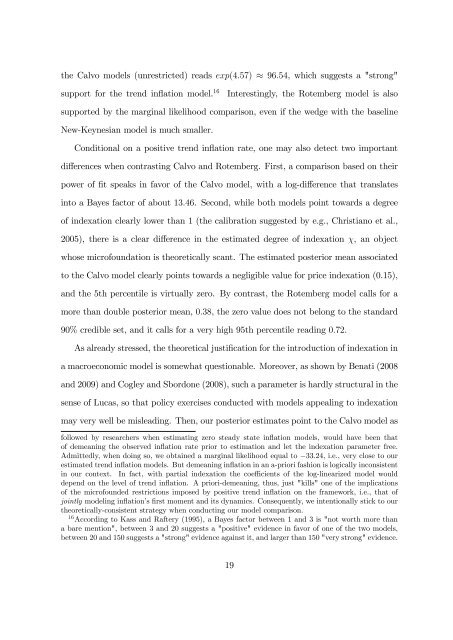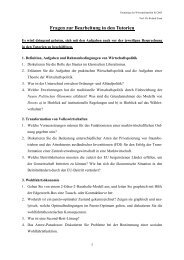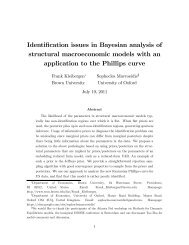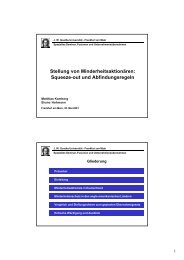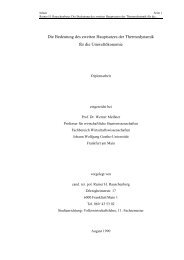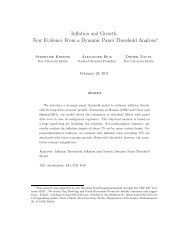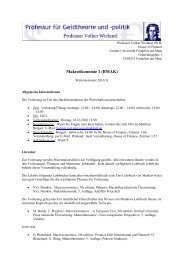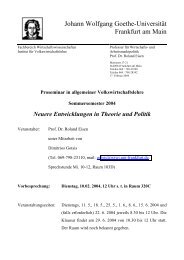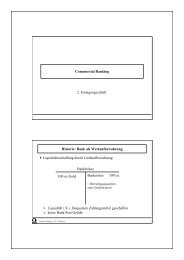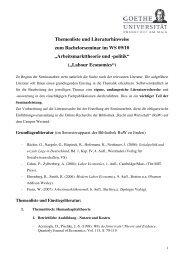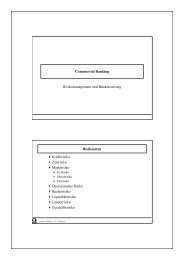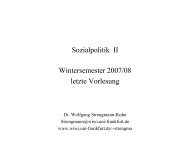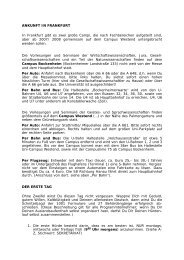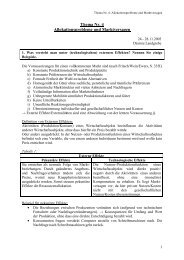Calvo vs. Rotemberg in a Trend Inflation World - Wiwi Uni-Frankfurt
Calvo vs. Rotemberg in a Trend Inflation World - Wiwi Uni-Frankfurt
Calvo vs. Rotemberg in a Trend Inflation World - Wiwi Uni-Frankfurt
You also want an ePaper? Increase the reach of your titles
YUMPU automatically turns print PDFs into web optimized ePapers that Google loves.
the <strong>Calvo</strong> models (unrestricted) reads exp(4:57) 96:54, which suggests a "strong"<br />
support for the trend <strong>in</strong>‡ation model. 16 Interest<strong>in</strong>gly, the <strong>Rotemberg</strong> model is also<br />
supported by the marg<strong>in</strong>al likelihood comparison, even if the wedge with the basel<strong>in</strong>e<br />
New-Keynesian model is much smaller.<br />
Conditional on a positive trend <strong>in</strong>‡ation rate, one may also detect two important<br />
di¤erences when contrast<strong>in</strong>g <strong>Calvo</strong> and <strong>Rotemberg</strong>. First, a comparison based on their<br />
power of …t speaks <strong>in</strong> favor of the <strong>Calvo</strong> model, with a log-di¤erence that translates<br />
<strong>in</strong>to a Bayes factor of about 13:46. Second, while both models po<strong>in</strong>t towards a degree<br />
of <strong>in</strong>dexation clearly lower than 1 (the calibration suggested by e.g., Christiano et al.,<br />
2005), there is a clear di¤erence <strong>in</strong> the estimated degree of <strong>in</strong>dexation , an object<br />
whose microfoundation is theoretically scant. The estimated posterior mean associated<br />
to the <strong>Calvo</strong> model clearly po<strong>in</strong>ts towards a negligible value for price <strong>in</strong>dexation (0.15),<br />
and the 5th percentile is virtually zero. By contrast, the <strong>Rotemberg</strong> model calls for a<br />
more than double posterior mean, 0:38, the zero value does not belong to the standard<br />
90% credible set, and it calls for a very high 95th percentile read<strong>in</strong>g 0:72.<br />
As already stressed, the theoretical justi…cation for the <strong>in</strong>troduction of <strong>in</strong>dexation <strong>in</strong><br />
a macroeconomic model is somewhat questionable. Moreover, as shown by Benati (2008<br />
and 2009) and Cogley and Sbordone (2008), such a parameter is hardly structural <strong>in</strong> the<br />
sense of Lucas, so that policy exercises conducted with models appeal<strong>in</strong>g to <strong>in</strong>dexation<br />
may very well be mislead<strong>in</strong>g. Then, our posterior estimates po<strong>in</strong>t to the <strong>Calvo</strong> model as<br />
followed by researchers when estimat<strong>in</strong>g zero steady state <strong>in</strong>‡ation models, would have been that<br />
of demean<strong>in</strong>g the observed <strong>in</strong>‡ation rate prior to estimation and let the <strong>in</strong>dexation parameter free.<br />
Admittedly, when do<strong>in</strong>g so, we obta<strong>in</strong>ed a marg<strong>in</strong>al likelihood equal to 33:24, i.e., very close to our<br />
estimated trend <strong>in</strong>‡ation models. But demean<strong>in</strong>g <strong>in</strong>‡ation <strong>in</strong> an a-priori fashion is logically <strong>in</strong>consistent<br />
<strong>in</strong> our context. In fact, with partial <strong>in</strong>dexation the coe¢ cients of the log-l<strong>in</strong>earized model would<br />
depend on the level of trend <strong>in</strong>‡ation. A priori-demean<strong>in</strong>g, thus, just "kills" one of the implications<br />
of the microfounded restrictions imposed by positive trend <strong>in</strong>‡ation on the framework, i.e., that of<br />
jo<strong>in</strong>tly model<strong>in</strong>g <strong>in</strong>‡ation’s …rst moment and its dynamics. Consequently, we <strong>in</strong>tentionally stick to our<br />
theoretically-consistent strategy when conduct<strong>in</strong>g our model comparison.<br />
16 Accord<strong>in</strong>g to Kass and Raftery (1995), a Bayes factor between 1 and 3 is "not worth more than<br />
a bare mention", between 3 and 20 suggests a "positive" evidence <strong>in</strong> favor of one of the two models,<br />
between 20 and 150 suggests a "strong" evidence aga<strong>in</strong>st it, and larger than 150 "very strong" evidence.<br />
19


